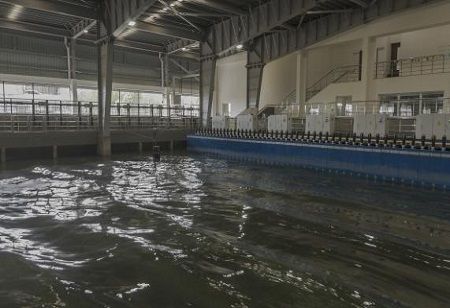-
Indian Institute of Technology Madras (IIT Madras) has launched Asia’s largest Shallow Wave Basin Research Facility that can cater to Indian research and industry requirements.
Development of this advanced facility is a key demonstration of the Research and Technical capabilities of IIT Madras and the Nation. This state-of-the-art facility is located at ‘Discovery’ Satellite campus in Thaiyur, about 36 km from IIT Madras.
This is a unique facility that can address challenging problems in Indian ports, waterways and coastal Engineering. It is a multi-directional shallow wave basin that can handle complex wave and current interactions.
This facility has been established through the National Technology Centre for Ports Waterways and Coasts (NTCPWC), a centre dedicated for technological innovations and the evolution of new ideas and breakthroughs in the port and maritime sector. It works as the technology arm of the Ministry of Shipping, Government of India and provides the needful technological support to ports, IWAI and other institutions.
Highlighting the significance of this Shallow Wave Basin Research Facility to India, Prof. Prof. K. Murali, Department of Ocean Engineering, IIT Madras, said, “This facility will position IIT Madras in international arena as one of the institutes that operates the large scale shallow wave basin for research and industry applications. We no longer need to depend on technology from other countries for the generation of waves in laboratory”.
Elaborating further, Prof. V. Sriram, also from the Department of Ocean Engineering, IIT Madras, said, “I can proudly state that, except a few items that we needed to import due to non-availability, rest of the Shallow Wave Basin was truly a ‘Make in India’ initiative. It was indigenously developed with most of the fabrications of the wavemaker done within IIT Madras itself. The entire architecture, communications and designs were made in-house for the operations and sustainability of the facility over the long term. The facility was conceived with the future government of India initiatives in mind for the new ports and coastal engineering as well as for inland waterways projects”.
Further, Prof. Torsten Schlurmann from Leibniz University of Hannover, Germany, which is running the world’s largest wave-current flumes and basins at the university level, said that this new research facility marks a significant milestone in the pursuit of knowledge and innovation.
Prof. Torsten Schlurmann who is also a long-term collaborator at IIT Madras added, that the facility will elevate IIT Madras’ status as a world-class institution for marine science and engineering by facilitating ground-breaking research and international collaboration across a broad range of disciplines.
This state-of-the-art research facility can be used for fundamental understanding as well as for application projects, where the influence of 3D waves on the structures can be critical. The basin can be used for harbour, coastal, offshore, inland waterways and shallow water manoeuvring-related projects. In these studies, sediment transport - mobile bed modelling, stability of the armour units, hydraulic and hydrodynamic performances, wave impact loading and the determination of the relevant design aspects due to climate change can be ascertained.
The key benefits of this facility include testing of varieties of the coastal structures, post impact analysis of the coastal structures, large solar floating plants, climate change effects and many more. This large-scale facility is one of its kind in the world with mobile wave maker, thus multiple projects can be carried out parallel, if required.
With the growing development of new ports in Indian coasts, this indigenous facility will help with the planning and is set to become a crucial tool. With the knowledge gained by creating such a large scale facility, IIT Madras is also set to help other institutes like NITs, IITs and research institutes in India to establish such cutting-edge research centres for their academic and research purposes.
The large dimensions of the basin and modular wave makers provide greater accessibility to handle multiple projects in parallel. Both waves, current and a combination of these can be generated. As of now, due to the available stroke, velocity limits and basin size, for example, a wave period range from 5 s- 18 s with a significant wave height upto 3m can be easily generated in 1:10 scale or in large scale easily. The circulation facility around the tank can be efficiently used to generate the currents inside the basin, this will be implemented in the near future.
The NTCPWC gives effective solutions to an extensive range of problems being faced in the industry through scientific support and also provides valuable education, applied research and technology transfer in maritime transportation at the local, regional, national and International levels.
🍪 Do you like Cookies?
We use cookies to ensure you get the best experience on our website. Read more...

